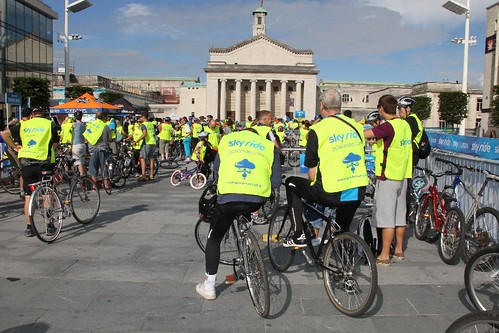(Just imagine how much nicer the picture above would be if the bottom half weren’t obliterated by eye-gouging yellow)
Hi-Viz yellow is a blot and a blight on the British landscape. Like the increasingly common “daylight” LED headlights, it is a solution that creates as many problems as it solves.
The ubiquity of the heavy yellow fabric, inevitably stained with grime up the back, disheartens me on a daily basis. It’s lazy, ugly and depressing, the antithesis of everything riding a bike should be.
I was once told a story of a watercolour painter who found that he found it increasingly hard to paint the glorious landscapes of Dartmoor on account of the eye-bleeding distraction of luminous yellow trooping across the Tors. Looking at the picture at the top of this post, I know how that painter feels.
I’m not totally opposed to bright colours. I wear a very bright pink Rapha gilet on occasion and at the right time of day or night, I’m a big fan of reflective materials to catch the eye of other road users. I’m a fan of eye-catching colours when the light is flat or there’s mist or fog – like this morning when I wore my Liquigas lime green gilet – which reduce visibility, but there are many more colours than simply yellow.
Hi-Viz yellow is symptomatic of a passive state in which that the wearer has been made safer simply by putting on the garment, rather than actively seeking to be safer by using lights, observation and other elements of roadcraft. That’s all before it’s often hidden behind a bag or rucksack.
Under sodium orange glare of street lighting I find that it tends to bleed into the background, rendering it no safer than anything other colour. Only things like the reflective panelling on Respro’s hump really stand out in those conditions.
More than anything it seems to be a peculiarly Anglo-Saxon obsession. I don’t think I’ve ever seen it making the same visual dent in the landscape of France, Italy, the Netherlands or Denmark, or the usually cautious Germany.
On clear day there is no justification for claiming that a cyclist is any harder to spot than a pedestrian crossing a road. No one has ever suggested in all seriousness that pedestrians should all wear yellow tabards for crossing the road as a matter of course.
But a significant proportion of British cyclists default to yellow rather than exploring the spectrum of opportunity, from the brightest of peacock blues to bold purples and glorious reds. Go out my readers and ride away from the boring, dare to push away from lazy choices.
Cycling should be about moving as part of your landscape, the sensation of oneness with the terrain around you, not gouging a visual tear in the landscape.
If tomorrow you burn your hi-Viz jacket or bib, then you will have done something to restore a little bit of beauty to the experience of cycling.

